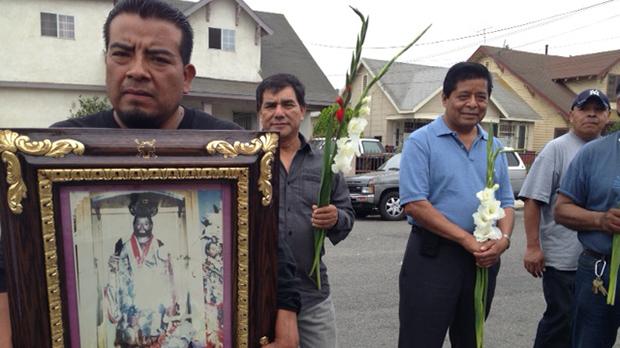A Push to Keep the Zapotec Language Alive in Los Angeles
In Los Angeles recently, people from the small town of San Bartolome Zoogocho, located in the southern Mexican state of Oaxaca, honored their patron saint. (Photo: Ruxandra Guidi)
Aaron Huey Sonnenschein, a linguistics professor at California State University, Los Angeles, is leading the group, focusing solely on the sound of Zapotec words. It's called the "phonics" method of learning. Sonnenschein adds that it is a methodology that linguist Leanne Hinton, a professor emeritus at the University of California, Berkeley, has innovated. Sonnenschein adds that it's an approach that works especially well with indigenous languages like Zapotec, which counts on few native speakers. The idea is to avoid the "years it would take to create a full language program and create one as we go along."
Aside from their Friday night meet-ups, the group in Los Angeles is creating a digital archive on Facebook featuring Zapotec words. It also has photos illustrating their meaning and their translation into English.
The web-based, interactive archive is meant for young, English-speaking Oaxacan Americans like 15-year-old Alison Morales.
"My whole family speaks Zapotec," says Morales. "My grandma would always say hi to me in Zapotec and I didn't know what it meant. So I decided to learn a few words here and there." His mom, Celerina Montes, couldn't be happier or more proud.
"I'm really proud to be Oaxacan," Montes says. "Of course, I'm also proud to be Mexican, and to speak Spanish." But, she adds, that with people who she knows speak Zapotec, she always bids them a good afternoon by saying "patir" rather than "buenos tardes."
In Los Angeles, Montes constantly runs into people from her Oaxacan village, San Bartolome Zoogocho. So, the class is also a place to see old friends, and to get the latest gossip from back home. But San Bartolome Zoogocho is also shrinking.
There are only about 400 people left there these days. On the other hand, Los Angeles is home to about 1,500 Zoogochenses.
"Most of us live here. We have a ghost town, basically, at home," says Odilia Romero, director of the LA-based Binational Organization of Indigenous Communities. It's hosting the Zapotec classes. "If the language was to be rescued, it would be here in LA. But if we don't do anything about it, by 2050, it'll be gone," says Romero.
On a warm Sunday afternoon, Romero and more than 50 other Zoogochenses stand outside a home in South LA, holding red gladiolus flowers. They wait for the brass band to start playing. Then, they march behind a framed 8-by-11 photo of an effigy of their patron saint, San Bartolome. The photo is taken inside a home and placed on an altar, surrounded by incense and more flowers. The display is similar to the type of ritual done back in the Mexican village, with the original effigy.
With flowers in his hand, Ted Lazaro says this little procession is one way of keeping his village's traditions alive. Speaking Zapotec is another.
"To say that you're indigenous is a dirty word for many people still. It implies that you have no education," says Lazaro. "But these days, our kids go to school and learn about many cultures, including their own. So now it's the kids that talk to their parents and grandparents here, and tell them, "Look, your culture is important.'"
Lazaro is a computer programmer by day. Lately, he's spent evenings and weekends practicing Zapotec with his children and making traditional masks. On August 24, dancers will wear those masks at a fiesta organized by people in Los Angeles with ties to San Bartolome Zoogocho. It is something they have done in LA for nearly 45 years.
